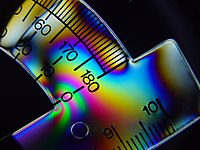
Photo from wikipedia
In recent years, the application of continuum mechanisms increased as they provide high dexterity, consume a low amount of space, and handle unforeseen collisions with ease. Typically, a deformation model… Click to show full abstract
In recent years, the application of continuum mechanisms increased as they provide high dexterity, consume a low amount of space, and handle unforeseen collisions with ease. Typically, a deformation model of the continuum is applied to compute task space poses from actuator variables. However, simple models usually lack accuracy, whereas accurate models are computationally demanding. This letter deals with the pose estimation problem for a continuum mechanism based on length sensors without using a deformation model. A subset of the sensors belongs to the actuating tendons with a fixed routing, whereas the rest of the length sensors can be placed freely. Two major issues are discussed. At first, a sensor placement strategy based on the coupling matrix is derived and discussed, which improves the observability for static pose estimation. Second, the feasibility of a sensor fusion between an inertial measurement unit and the length sensors to enhance the pose estimation is presented. Both investigations are done experimentally on DAVID. By placing the additional sensors correctly, the maximum estimation error can be lowered by 50% in comparison to poorly placed sensors.
Journal Title: IEEE Robotics and Automation Letters
Year Published: 2019
Link to full text (if available)
Share on Social Media: Sign Up to like & get
recommendations!